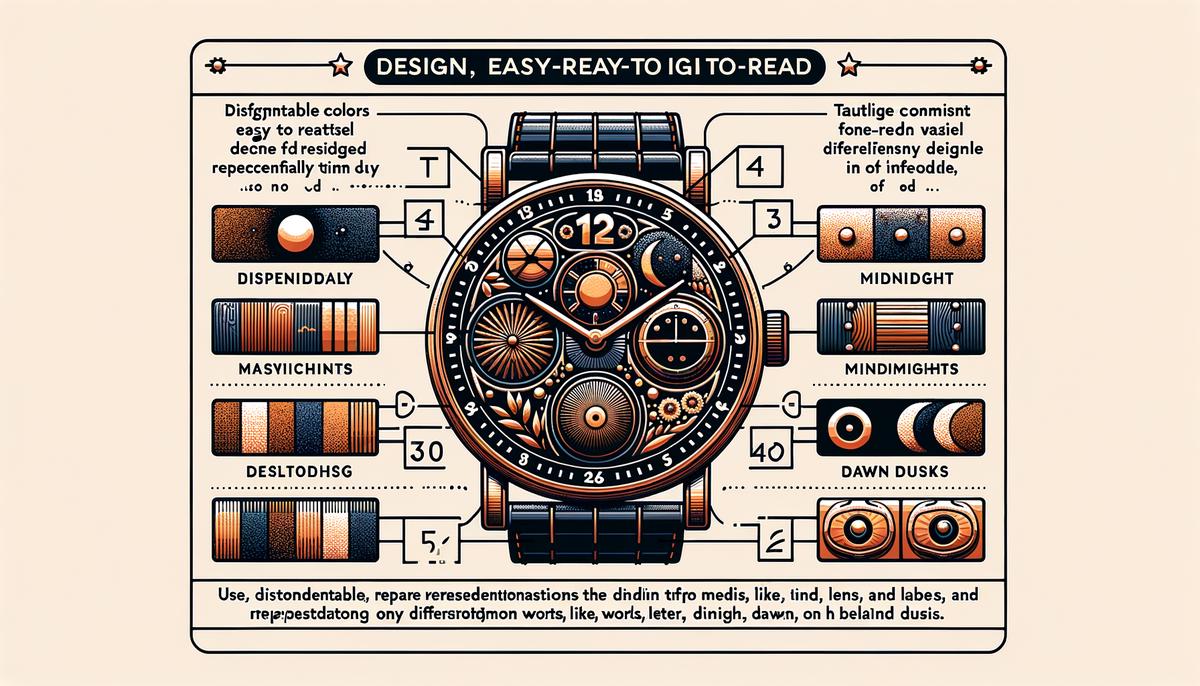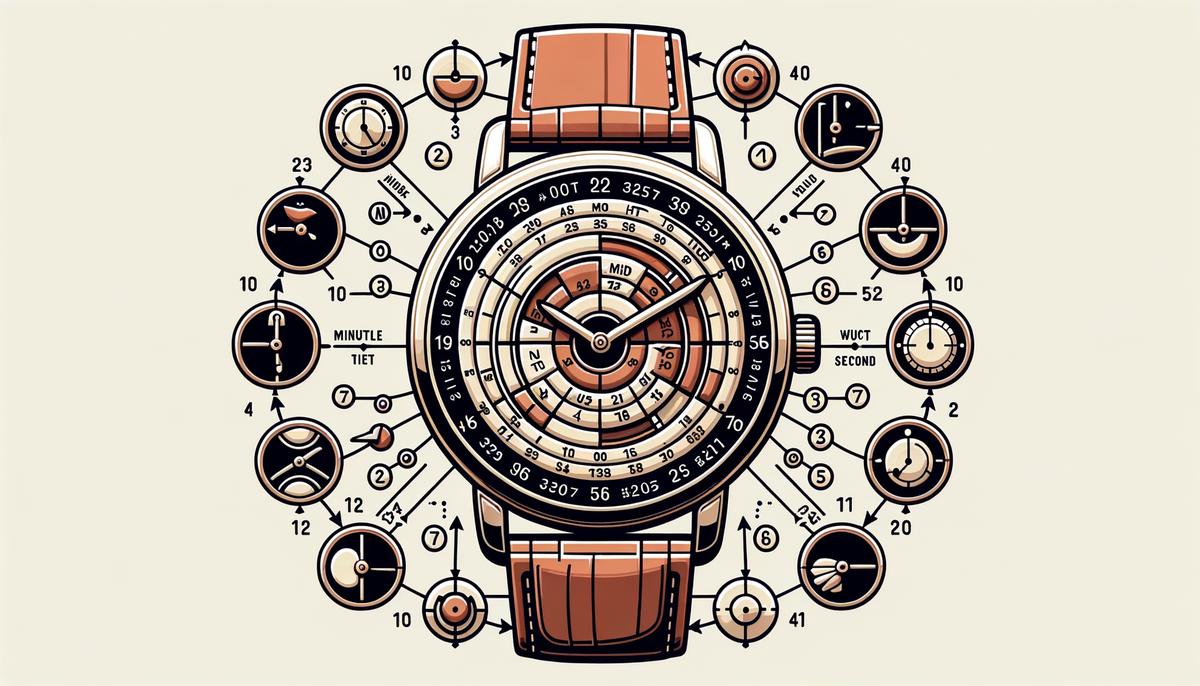Timekeeping has evolved significantly through the ages, with various mechanisms capturing the essence of each moment in unique ways. Among these developments, the 24-hour watch movement stands out as a distinct approach to tracking time, offering a full day’s cycle at a glance. This article explores what makes the 24-hour watch movement special and its appeal to those who appreciate horological innovations.
Understanding 24-Hour Movement
Understanding the 24-Hour Watch Movement
The concept of time tracking has taken various forms through the ages, but one of the most intriguing evolutions in horology is the 24-hour watch movement. This distinct mechanism, differing significantly from the conventional 12-hour format, opens a window into a world where each moment in the day is captured uniquely. Let’s delve into what sets 24-hour watch movements apart and why they present a special allure to watch enthusiasts.
What is a 24-hour Watch Movement?
Distinct from the commonplace 12-hour watches, a 24-hour watch movement completes one rotation of the hour hand around the dial in a full 24-hour cycle. This means, instead of the hour hand circling twice in a traditional watch to account for AM and PM periods, in a 24-hour watch, the hour hand makes one extended journey from 00 to 23, marking each hour of the day distinctly.
The Unique Appeal
- One Glance Day and Night – A 24-hour watch embodies simplicity in understanding time. With a single observation, you can immediately ascertain whether it’s morning, afternoon, or night, eliminating the need for AM/PM confusion. This is especially advantageous for those in professions needing quick and unambiguous time readings, such as military personnel or travelers synchronized to GMT (Greenwich Mean Time).
- Rare Craftsmanship – Due to their less common nature, 24-hour watches are often crafted with higher precision and care. They stand as hallmarks of watchmaking excellence, combining traditional expertise with the quest for distinctive functionality. This rarity and craftsmanship make them highly sought after by collectors and horology enthusiasts.
- Education and Utility – For ones learning the nuances of time or those engaged in specific arenas like astronomy, a 24-hour watch serves as both a functional tool and an educational device. It aligns closely with the 24-hour format used in numerous scientific and military settings, offering utility beyond mere time-telling.
Navigating a 24-Hour Dial
Reading a 24-hour dial may initially appear daunting; however, the transition can be smooth with a bit of practice. Unlike traditional dials where the numbers might go from 1 to 12 twice, the 24-hour clock runs from 00 (or 1) through to 24 at sequential intervals. So, when you read the time, if the hour hand points to 15, it is 3 PM; if it points to 22, that translates to 10 PM, and so forth.
Who Should Consider a 24-Hour Watch?
24-hour watches are suited for those who appreciate horological innovations, crave a watch with an educational twist, or require a tool that offers clear differentiation between day and night in its display. Moreover, their uniqueness and craftsmanship can add a distinctive character to one’s collection or daily wear.
Conclusion
Voyaging into the realm of 24-hour watch movements unlocks an appreciation for time’s singular journey through the day. Whether drawn by their aesthetic distinction, historical significance, or the simple joy of owning a piece of nuanced horology, a 24-hour watch stands as a beacon of uniqueness. With their mix of utility, rarity, and craftsmanship, these watches not only tell time but tell it in a way that challenges conventions and adds depth to the horological narrative.

Reading a 24-Hour Dial
Reading a 24-hour watch dial efficiently requires understanding its layout and how it signifies time differently from the standard 12-hour watch. Here’s your guide to mastering this timepiece.
Understanding the Dial:
A 24-hour dial displays time over a full day—meaning the hour hand completes one cycle every 24 hours. Instead of making two rotations per day like on a 12-hour dial, the hour hand of a 24-hour watch moves at half the speed. Numbers typically range from 00 or 24 at the top, signifying midnight, to 23 marked at the hour before midnight.
Start with Midnight:
Look for the 00 or 24 at the top center of the dial. This position represents midnight. In a 24-hour format, the day starts at 00:00 (midnight) and ends at 24:00 (also midnight, marking the start of a new day).
Reading the Hours:
Progressing clockwise from the top, every mark on the dial represents a passing hour of the day. For instance, if the hour hand points directly at 15, you’re looking at 1500 hours, or what is 3:00 p.m. in a 12-hour format. This direct approach to marking hours cuts out the AM/PM confusion, making timekeeping straightforward and precise.
Understanding the Minutes:
Minutes work much like they do on any watch. The minute hand circles the dial in a regular 60-minute cycle. Combine the position of the minute hand with the hour to read the exact time. For example, if the hour hand is between 15 and 16 (3 and 4 p.m.) and the minute hand is at 30, the time is 15:30, or 3:30 p.m.
How to Read At Half Past:
If the hands are directly halfway between hour markings—for instance, between 22 (10 p.m.) and 23 (11 p.m.)—you’re in a half-past situation. Look then to the minute hand to discern whether it’s nearing the top or bottom half of the hour.
Visualize Standard Times in 24-Hour:
To translate a 24-hour time to its traditional 12-hour counterpart, subtract 12 from any time marked beyond noon (above 12). So, when you see the hour hand at 17, subtract 12 to revert it to 5 p.m.—this is how you read traditional hours on a 24-hour dial without conversion confusion.
Practical Tips:
- Regular reference can hasten familiarity. Wear your 24-hour watch daily to become accustomed to this mode of time-reading.
- Quick checks during key moments of your day—such as noon (12:00) and midnight (00 or 24:00)—can serve as helpful orientation points.
- If puzzling over PM times, remember the simple subtraction rule: Post-noon (greater than 12), subtract twelve.
Embracing a 24-hour watch may initially challenge your usual time-reading habits, given its distinct approach to marking the hours. Yet, this style of watch offers unambiguous time-telling and an enriching perspective on tracking your day’s passage. With practice, a glance at your wrist will provide precise timing, allowing you to savor every moment across a 24-hour landscape.

Adjusting and Setting a 24-Hour Watch
Setting a 24-hour watch might sound daunting, but it’s a straightforward process once you understand the mechanism. Unlike traditional 12-hour watches, a 24-hour watch represents the entire day on a single rotation of the hour hand. Whether you’re holding a vintage piece or a modern marvel, follow these steps to ensure accurate timekeeping.
Step 1: Pull Out the Crown
Start by locating the crown on the side of your watch. This is the small knob you’ll use to make adjustments. Gently pull the crown out to the position where you can set the time. Some watches have different positions for setting the date and time, so make sure it’s in the correct setting position for time adjustment.
Step 2: Understand AM and PM
Before spinning the crown, recognize that, unlike a typical watch, the hours will go from 00 to 23. Hours from 00 to 11 refer to AM times, while hours from 12 to 23 denote PM times. There is no need to toggle AM or PM settings as in some digital watches, as the entire day’s cycle is visible on the dial.
Step 3: Set the Hour
Turn the crown until the hour hand aligns with the correct hour on the 24-hour scale. If it’s 7 in the evening, point the hour hand to 19, as that signifies 1900 hours or 7 PM in a 24-hour convention.
Step 4: Set the Minutes
Now for the minutes – keep turning the crown until the minute hand is precisely meeting your desired minute. The minutes operate just like they would on a traditional watch: a full circle of the minute hand around the dial represents one hour.
Step 5: Adjusting for Precision
If your watch features a seconds hand and you want to set it accurately, you might want to first check an accurate external time source like an atomic clock or your phone. Align your watch’s seconds hand accordingly by stopping it right at 00 to synchronize perfectly.
Step 6: Pushing Back the Crown
Once your watch displays the right time, gently push the crown back into its original position closer to the watch casing. This not only secures the time you’ve just set but also ensures water resistance is re-established if your watch has this feature.
Step 7: Doing a Final Check
Give your watch dial another glance to validate that everything is as it should be. It’s a good habit to cross-verify with another reliable time source. This final step ensures that you haven’t mistakenly set AM for PM or vice versa.
Care Modalities post Setting
Remember, handling your watch for setting or adjustments is a task requiring gentle finesse – undue pressure or force when pulling and pushing the crown could affect the internal mechanisms of your timepiece. Again, these marvels demand respect for their intricate designs and functionalities. Regular checks, gentle handling, and care will keep them ticking accurately as they elegantly wrap your wrist, accompanying you through each second of the day.

As we explore the intricacies and appeal of 24-hour watches, it becomes clear that these timepieces are more than just tools for telling time; they are symbols of precision, craftsmanship, and uniqueness in the world of horology. They challenge conventional time-telling while offering an enriching perspective on how we view our day. Embracing a 24-hour watch not only enhances one’s appreciation for meticulous engineering but also adds a distinctive character to one’s daily life.
Leave a Reply